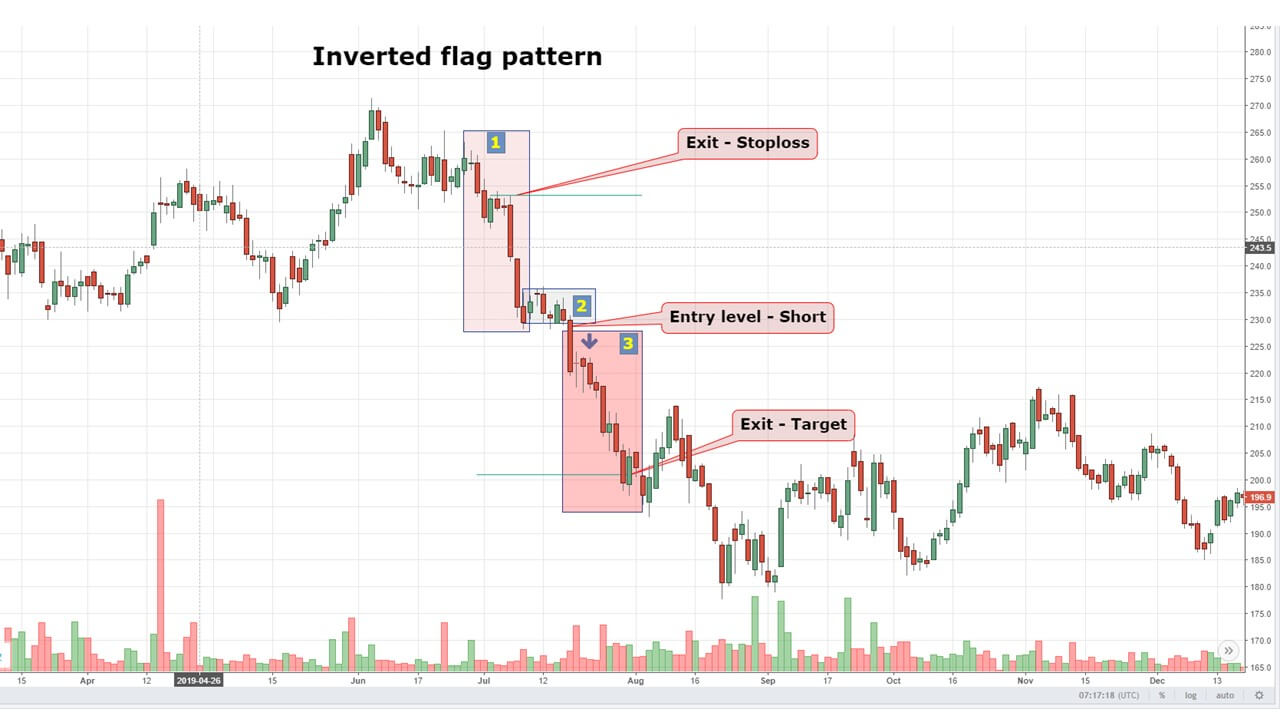Inverted Flag Pattern
The inverted flag pattern, also known as the inverted flag and pole pattern or reverse flag pattern, is a bearish continuation pattern that signals a potential continuation of the downtrend in the market. This pattern is characterized by a sharp decline (the pole) followed by a brief consolidation period (the flag), which typically slopes upward against the prevailing downtrend.
Pattern Identification
Inverted Flag Pattern Meaning
The inverted flag pattern means that the market is taking a short pause before continuing its downward trajectory. Here’s how to identify the pattern:
- Pole Formation: Look for a steep and rapid decline in the price, which forms the pole of the pattern.
- Flag Formation: Following the decline, the price consolidates in a small upward or horizontal channel, creating the flag. This phase represents a temporary halt in the downtrend.
- Breakout Confirmation: The pattern is confirmed when the price breaks down below the lower boundary of the flag, indicating the resumption of the downtrend.
Trading Strategies
Inverted Flag Trading Strategies
- Entry Point: Enter a short position when the price breaks below the lower boundary of the flag.
- Stop Loss: Place a stop loss above the upper boundary of the flag to limit potential losses.
- Profit Target: Set a profit target based on the height of the pole. For example, if the pole represents a ₹100 decline, aim for a similar ₹100 profit from the breakout point.
Formation and Significance
The inverted flag pattern forms when there is strong selling pressure, leading to a sharp decline (pole). The subsequent consolidation (flag) occurs as the market temporarily stabilizes, but the overall bearish sentiment remains. The significance of the inverted flag pattern lies in its ability to signal the continuation of the downtrend, offering traders an opportunity to enter short positions.
Comparison with Other Patterns
- Inverted Flag vs. Regular Flag: Both the inverted flag and regular flag patterns share similar characteristics technically. However, the regular flag pattern is typically considered bullish, while the inverted flag specifically indicates a bearish formation.
- Inverted Flag vs. Double Top: Both the inverted flag and double top are bearish indicators. The double top suggests a balance between supply and demand before supply eventually dominates. In contrast, the inverted flag indicates a strong dominance of supply over demand, leading to a steeper price decline.
Glossary of Terms
- Bearish Continuation Pattern: A chart pattern indicating the continuation of a downtrend.
- Consolidation: A phase where the price moves sideways within a range, indicating a pause in the trend.
- Breakout: The point at which the price moves out of the consolidation phase, confirming the pattern.
FAQs
What does the inverted flag pattern mean? The inverted flag pattern means a continuation of the downtrend after a brief consolidation period.
How reliable is the inverted flag pattern? The reliability varies depending on market conditions, but it is generally considered a strong bearish continuation signal.
What is the difference between an inverted flag and a reverse flag pattern? There is no difference; both terms refer to the same pattern.
If you want to learn more about technical analysis, visit our stock market training page.

